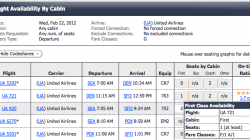This post is part of a continuing series on using fare rules and inventory data to book a trip at the best price.
- Understanding Airline Inventory
- Finding Fare Class Availability
- Matching Availability to Published Fares
- Deciphering Fare Rules
- Using Airline Fare Rules to Save Money
Yesterday I promised to show you how to put the published fares, booking class availability, and fare rules into action. Here’s an example for a possible trip I may take to New York in June. I prefer to fly United, which has hub in Newark (EWR), so I automatically limited my search results, but you could leave it open if you wanted to see competing offers as well as options to fly to JFK (including United’s p.s. service) or La Guardia. I also only looked at round trip fares, although sometimes it can be worth looking into purchasing two one-way fares. Perhaps you are unsure about one of the dates and want the ability to change or cancel one leg without having to rebook the entire trip.
Because of these limitations, the published fares I was returned for that date only vary with respect to the particular rules of each fare. All of my examples today were found using ExpertFlyer, a great web-based tool that costs $99 for an annual premium subscription (a reasonable price if you book your own travel and fly at least twice a month).
As you can see in the example below, some booking classes have several fares to choose from. There are a couple M fares available at either $1,112 or $1,228. There are also very similar prices for some fares that will book into different booking classes. The cheapest options, LA14HS and WA14HS, are each only $338. Looking briefly at the fare rules, I couldn’t identify any difference between them, but it’s generally better to choose the higher-ranking W fare for upgrades and waitlist reasons.
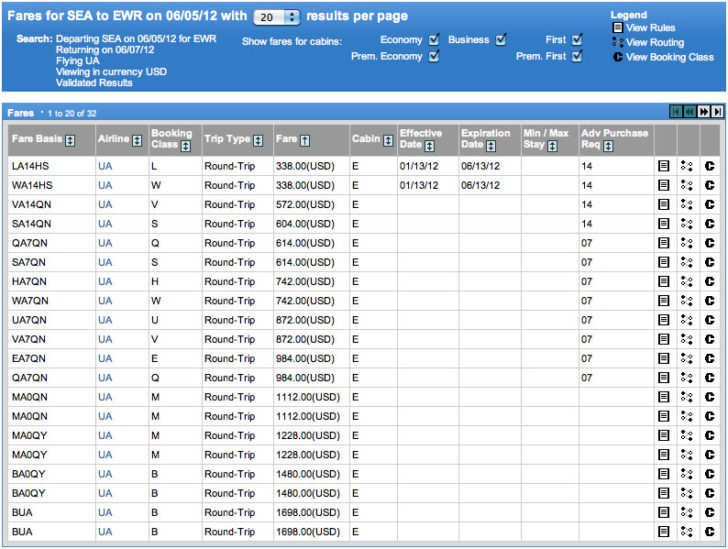
There is also another W fare, WA7QN, that cost $742. The difference between these fares is that the first had a 14-day advance purchase restriction and the second only requires 7 days. Also, the cheaper fare is a limited-time offer. Note that it is only effective for travel between January 13 and June 13. This is not to say any of these fares couldn’t be pulled in the meantime, but the rest of the list are standard prices that will remain in effect for travel until end-of-schedule (EOS). EOS is generally 330 days out at most airlines and the maximum time in the future you can purchase any ticket.
Since the WA14HS fare looks like the best deal, let’s take a look at the fare rules. It goes on for pages and pages so I’m just showing you the first part.
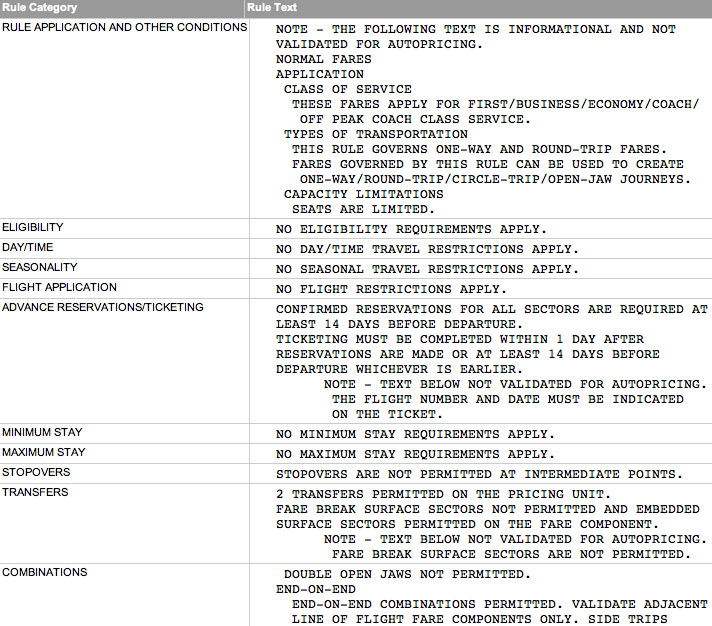
A lot of these terms should be familiar from my post yesterday. For the most part, this fare has few restrictions other than the usual ones for an advance-purchase, non-refundable ticket. There are no requirements for specific days or times of travel (e.g., you don’t have to take a red-eye on Saturday), and there are no minimum stay requirements. Two connections (“transfers”) are permitted, but that only leaves you one each way. As is usual with domestic fares, no stopovers are allowed, so all connections have to be under 4 hours.
End-on-end combinations are permitted, which means you can combine it with another fare, such as one from Newark to Miami. Further on, it specifies additional rules for constructing open jaws or combining this fare with an international fare. Each region has its own rules for combinations. For example, this quote outlines combinations with fares heading from Area 1 (the Americas) to Area 3 (Asia) and requires that you fly on Continental, United, or ANA.
END-ON-END
END-ON-END COMBINATIONS PERMITTED WITH FARES BETWEEN
AREA 1 AND AREA 3. VALIDATE ADJACENT LINE OF FLIGHT
FARE COMPONENTS ONLY. SIDE TRIPS PERMITTED WITH NO
RESTRICTIONS. TRAVEL MUST BE VIA THE POINT OF
COMBINATION.
PROVIDED –
COMBINATIONS ARE FOR CARRIER CO/UA/NH IN ANY RULE
IN TARIFF
IPRP – BETWEEN THE USA/CANADA-AREA 2/3 VIA PAC.
COMBINATIONS ARE FOR CARRIER CO/UA/NH IN ANY RULE
IN TARIFF
IPRPJ – BETWEEN USA/CA/AMER.SAMOA/
MICRONESIA-AREA 3.
What about routing? If you click on the zig-zag button to the right of the fare on ExpertFlyer’s page, you’ll be able to see the permitted routing for this fare. It turns out you can only travel nonstop. So to give you another example, I looked up fare LA14CN from Seattle to New Orleans, traveling non-hub to non-hub in United’s network. There are two possible options.
1. SEA-SFO/PHX/LAX/LAS/HOU/DEN-MSY
2. SEA-SFO/PHX/LAX/HOU/DEN-MSY
Nothing particularly fancy going on here. As you’d expect, you are allowed one stop. Lately United has really been cutting down on the mileage running opportunity. There used to be more complex routing permitted that would let you travel to all kinds of crazy places. Note, however, that you don’t get to choose any of the hubs. You are required to stop in SFO, LAX, IAH (HOU means Houston), or DEN. ORD, EWR, and IAD are not permitted, likely because they would increase the distance traveled more than the others. See? United is forcing you to take a more direct route to get the cheapest price. Sensible, but not exactly what I would like. PHX is also listed, likely to accomodate the hub of United’s Star Alliance partner US Airways.
But alas, I am not going to party in New Orleans. I have to go to New York. *grumble* So let’s see what the booking class availability looks like for that W fare.
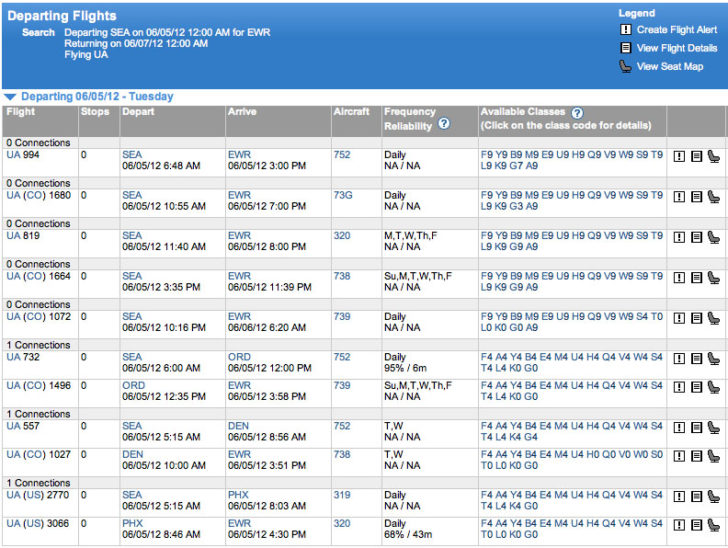
Yes! There’s W space on all the nonstop outbound options that match with the fare rules. The same is true with the return leg. Just to confirm, I’ll pop over to ITA to price out the trip.
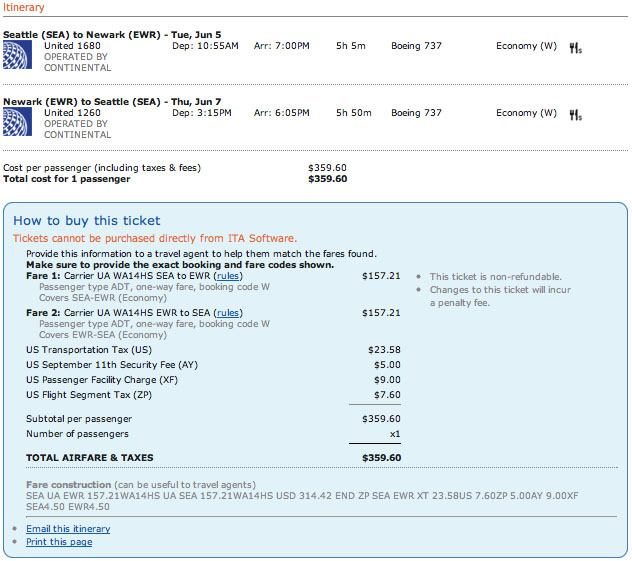
The price is a little higher than $338 even though the fare construction notes at the bottom indicate that ITA used the WA14HS fare I found earlier. That’s because that price only included the base fare and the US Transportation Tax. The various other AY, XF, and ZP fees bring the total to $359.60.
There are lots of other nitty gritty details about fare construction that you could learn, but these are the basics that will help you identify (1) the lowest published fare, (2) the rules required to purchase that fare, and (3) how to match up the availability on specific flights.

